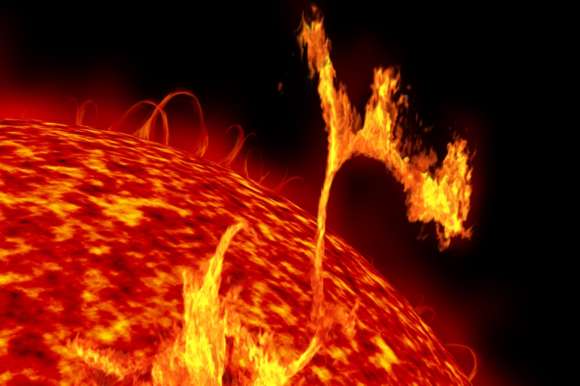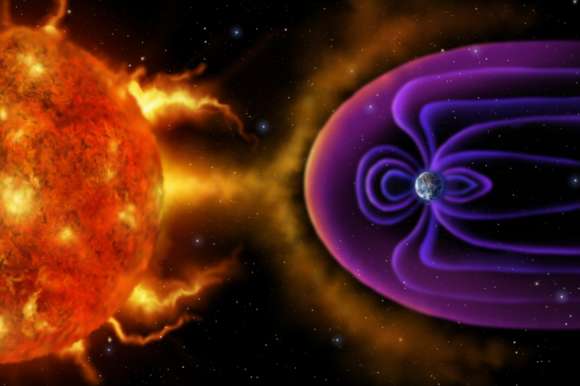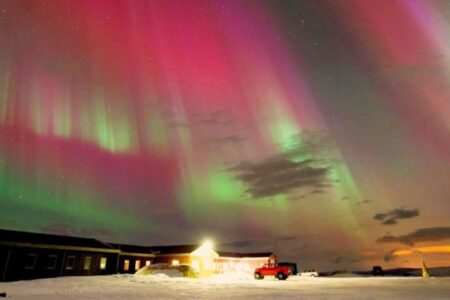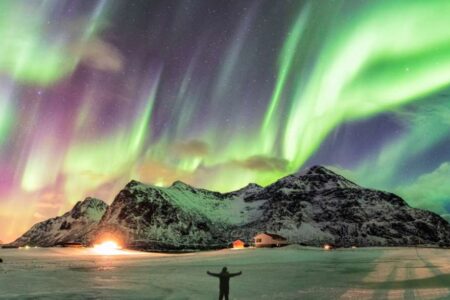The northern lights (also known as the aurora borealis) are a spectacular display of colour and light in the night sky. There’s something otherworldly about this magical and mystical performance. And seeing it in person is an unforgettable experience.
But what creates the northern lights? How are those beautiful waves of colour formed? And what causes the aurora to be seen further south? Here, we explore the science to explain how the northern lights are formed.
What causes the northern lights?
The northern lights are caused by solar particles from the sun colliding with atoms in Earth’s atmosphere.
Solar storms on the surface of the sun release clouds of electrically charged particles out into space. These particles can travel for millions of miles and some collide with Earth.
Earth’s magnetic field bounces many of these solar particles away, back into space. But some become caught in our planet’s magnetic field and are accelerated towards the north and south poles.
These particles collide with atoms and molecules in Earth’s atmosphere, creating a chemical reaction. Energy created by the collision is released as colourful light, which dances anywhere from 80 to several thousand miles above the surface of the Earth.
What creates the aurora colours?
The aurora borealis appears in many different colours — green, red, blue, purple, pink and yellow. But how are these beautiful aurora colours created?
We know that the northern lights occur when solar particles collide with atoms in Earth’s atmosphere. The type and altitude of these atoms help to determine the aurora colours we see.
For example, when solar particles slam into oxygen atoms in the atmosphere, we get a fluorescent green or yellow colour at lower altitudes — and red at higher altitudes, where the air is less dense. And when solar particles hit nitrogen atoms, we’re more likely to see blue, violet and pink colours.
The most common aurora colour is green. This is because there are high concentrations of oxygen at altitudes of 100 to 150 kilometres — and this is where most solar particles crash into the atmosphere. In times of intense solar activity, a vibrant, multi-colour display is more likely.
What are sunspots?
The intensity of the northern lights is shaped by activity on the surface of the sun. The biggest clue that a bright aurora display is on the way? Sunspots.
Sunspots are areas that appear as dark spots on the surface of the sun. These temporary spots can last for days or months and can be seen through a special solar telescope.
Although sunspots are incredibly hot, they’re cooler than the surrounding solar surface. They form in areas where the sun’s magnetic field is so strong that it prevents some heat from reaching the surface of the sun.
Thanks to that magnetic field, the area around a sunspot is volatile. As the magnetic field twists and shifts, it can release sudden explosions of energy, known as coronal mass ejections (CMEs).
These explosions send charged particles hurtling out into space and they’re one of the causes of the northern lights. So the more sunspots there are on the sun’s surface, the more solar and auroral activity we’re likely to see.
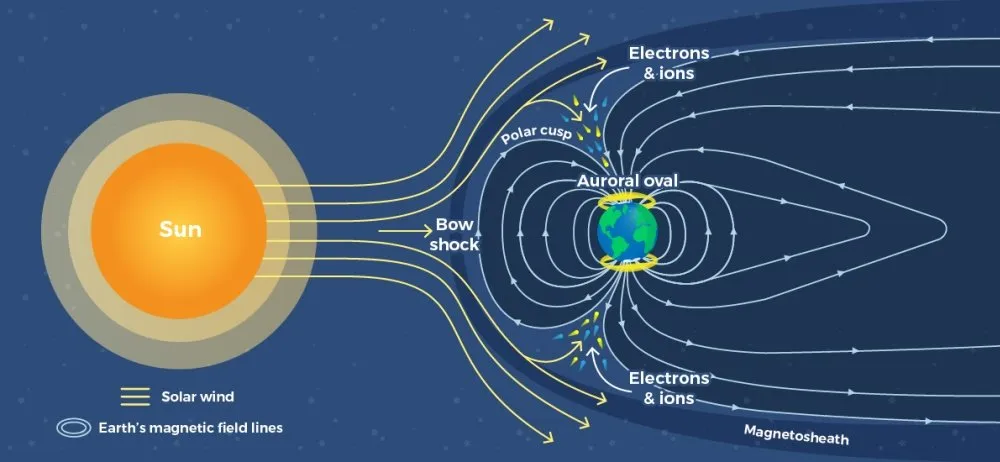
What is a coronal mass ejection?
A coronal mass ejection (or CME) is a huge explosion that sends a massive cloud of charged particles into space at over a million miles per hour. It can take a couple of days to reach Earth but — when it does — it can trigger spectacular northern lights displays in the night sky.
The number of CMEs varies depending on where the sun is up to in its 11-year cycle. At the solar minimum, there’s around one CME per week. At the solar maximum, there are around two to three CMEs per day.
At the moment, we’re just past the peak of the solar maximum. While this is an excellent time to see the northern lights, it doesn’t mean it’s now or never. That’s because there’s another solar phenomenon that causes the aurora borealis — the solar wind.
What is the solar wind?
Even when there’s no big solar explosion, the solar wind sends a steady stream of charged particles into space.
The solar wind is released by coronal holes — cooler, darker patches on the sun. These can form at any time or location, but they’re especially common around the time of the solar minimum.
The solar wind flows continuously in all directions, even on days when solar activity is relatively quiet. And it’s sometimes enough to spark a breath-taking aurora all on its own.
What is a geomagnetic storm?
When a strong CME or a fast-moving solar wind slams into Earth’s magnetic field, it creates a disturbance called a geomagnetic storm.
These storms create strong aurora displays. During the most violent storms, the northern lights are visible further south than usual, in places like Scotland, northern Germany and the northern USA.
Geomagnetic storms are ranked by intensity using the G-scale, which ranges from G1 (a weak storm) to G5 (an extremely strong storm). They can also be measured using the Kp index, with G1 equivalent to Kp = 5.
G5 storms are very rare. But G1 storms are much more common and — even at this weaker level — are enough to cause magnificent northern lights displays in Arctic regions.
Do the northern lights happen every night?
The northern lights occur all year round. But you can’t always see them.That’s because aurora visibility is affected by the following:
- Solar activity. Strong solar activity means bigger, brighter and more colourful aurora displays.
- Location. Charged particles from the sun are driven towards the North Pole. So the further north you are, the better your chance of seeing the northern lights.
- Light pollution. Lights from towns and cities often outshine the aurora. You have the best chance of seeing the northern lights if you’re out in the dark countryside.
- Sunlight. During summer in the northern hemisphere, nights are short. In some places, the sun doesn’t set at all, making it impossible to see the aurora.
- Clouds. There could be an incredible aurora display dancing above. But if it’s a cloudy night, it’ll be blocked from view.
Want to see the northern lights for yourself?. You have the best chance of seeing the aurora if you travel to the Arctic Circle from September to early April. Once you’re there, venture into the Arctic wilderness, in search of dark starry skies, free from clouds — and keep your eye on the solar forecast.
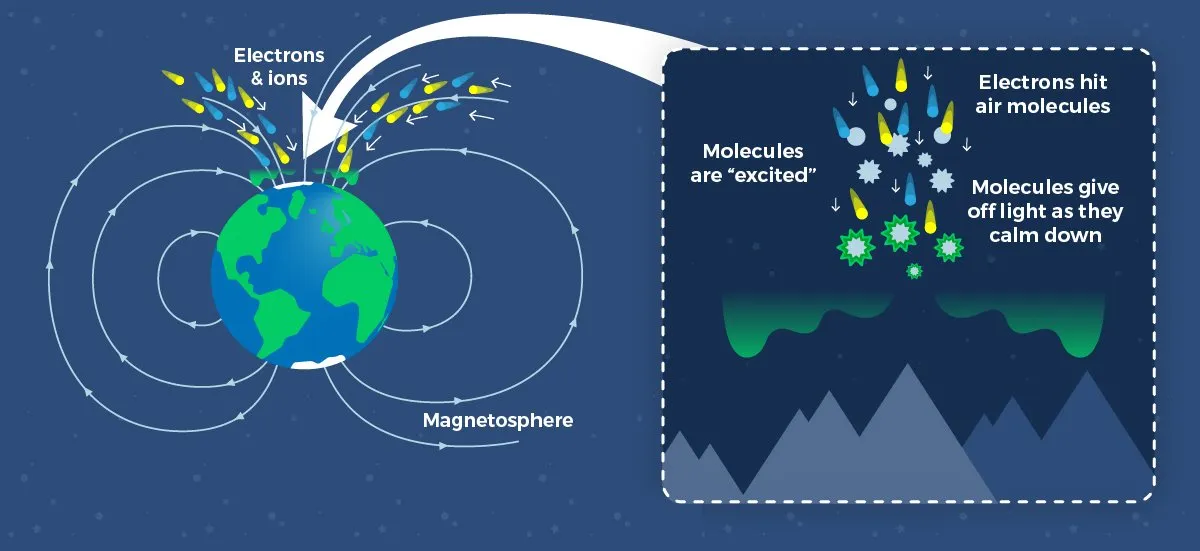
How long are the northern lights visible?
A northern lights display can last anything from a few minutes to a few hours, depending on solar activity. It can appear and disappear quickly or fade in and out slowly. You may even be lucky enough to see multiple displays in a single night.
To find out when the aurora borealis is most likely to be visible on any given night, you can check the solar forecast. This is a prediction, broken down into three-hour periods, of how strong and bright the northern lights are likely to be.
Why are the northern lights only in the north?
The northern lights (or aurora borealis) are created when charged particles are driven by Earth’s magnetic field to the North Pole, where they interact with atoms in the atmosphere.
But exactly the same phenomenon is happening on the other side of the planet. Charged particles are also driven towards the South Pole. Here, the resulting display is known as the southern lights (or aurora australis).
The southern lights are harder to see because there’s very little accessible land close to the South Pole.
In the northern hemisphere, the best places to see the aurora borealis are northern Europe, Russia, Alaska and Canada. If you’re planning a northern lights trip, check out the following information to discover the very best aurora destinations:
- Where to see the aurora in Iceland
- Where to see the aurora in Norway
- Where to see the aurora in Sweden
- Where to see the aurora in Finland
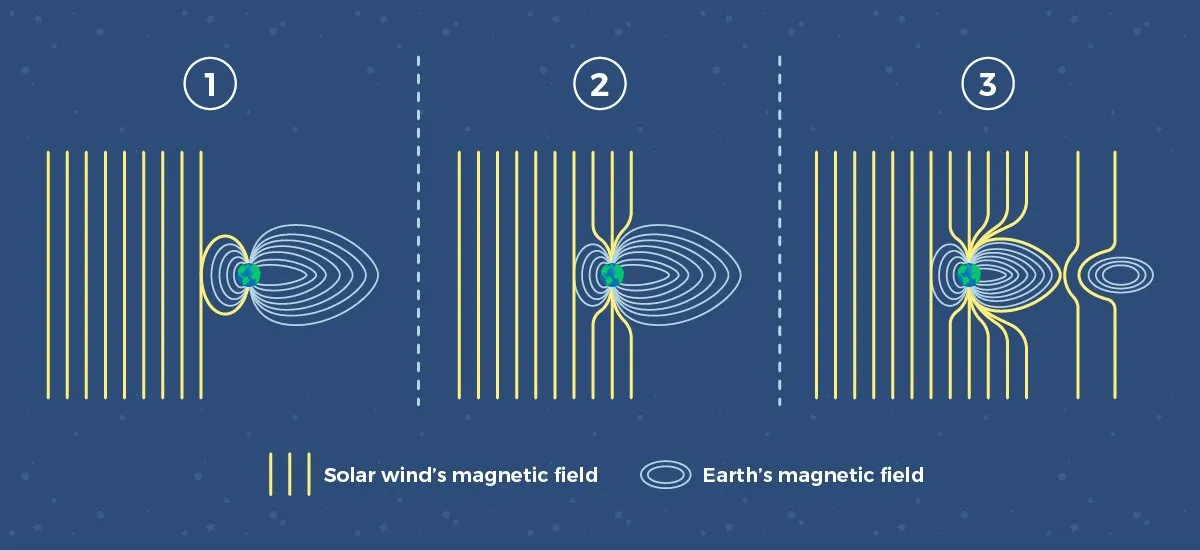
Do other planets have auroras?
The solar wind travels around our solar system. So any planet with an atmosphere and a magnetic field is likely to have its own version of the northern lights.
Scientists have been able to view auroras on Venus, Mars, Jupiter, Saturn, Uranus and Neptune, although some have stronger displays than others.
Jupiter — which has a particularly strong magnetic field —is known to have aurora displays that are much larger and more intense than those here on Earth.
Want to see the northern lights at their bright and brilliant best?
The northern lights shine brightest close to the Arctic Circle, deep in the countryside, with dark starlit skies above.
Because the sun shines in the Arctic for most of the summer, you need to travel to this region from September to early April. During this time, there are enough hours of darkness to give you a good chance of seeing the aurora.
On a tailor-made Aurora Nights holiday, you track down the northern lights with an expert aurora guide by your side.
With insight into local microclimates, solar forecasts and picture-perfect landscapes, your guide maximises your chances of seeing this spectacular natural phenomenon in its bright and brilliant glory.
Excited to see the northern lights? Ready to plan your aurora holiday? Start by browsing our most popular tours:
- Northern lights holidays to Iceland
- Northern lights holidays to Norway
- Northern lights holidays to Sweden
- Northern lights holidays to Finland
Then, get in touch with the Aurora Nights travel experts to tell us about your holiday wish list and start planning the northern lights tour of your dreams.
